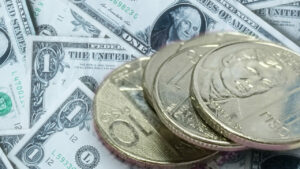THE PESO could continue to rise against the dollar this week after the US Federal Reserve chief signaled the start of their policy easing cycle as early as next month.
The local unit closed at P56.333 per dollar on Thursday, strengthening by 16.7 centavos from its P56.50 finish on Wednesday, Bankers Association of the Philippines data showed.
This was the peso’s best finish in more than four months or since its P56.315-a-dollar close on April 2.
Week on week, the peso appreciated by 91.2 centavos from its P57.245 finish on Aug. 16.
Philippine financial markets were closed on Aug. 23 (Friday) for a special non-working holiday in observance of Ninoy Aquino Day, which was moved from the original Aug. 21 date.
Local markets will remain closed on Aug. 26 (Monday) in commemoration of National Heroes’ Day.
The peso mounted a four-day winning run against the dollar last week as markets awaited the US central bank’s annual economic symposium in Jackson Hole, Wyoming, where Fed Chair Jerome H. Powell was set to speak on Friday.
For this week, the local unit may strengthen further against the dollar as Mr. Powell’s speech bolstered expectations of a September rate cut in the world’s largest economy, Rizal Commercial Banking Corp. Chief Economist Michael L. Ricafort said in a Viber message.
“The US dollar slumped 1% with the Fed’s dovish pivot, so expect a sustained appreciation in the peso [this] week,” Security Bank Corp. Chief Economist Robert Dan J. Roces said in a Viber message.
The dollar fell on Friday after Mr. Powell gave an unambiguous signal that the long-anticipated US interest rate cut would come next month, Reuters reported.
The weak dollar also saw the euro hit a 13-month high, and the US currency marked a 17-day low versus the yen.
At his keynote speech to the Kansas City Fed’s annual economic conference in Jackson Hole, Wyoming, Mr. Powell said, “The time has come for policy to adjust,” given that upside risks to inflation have diminished and downside risks to employment have increased.
“We do not seek or welcome further cooling in labor market conditions,” Mr. Powell said. “We will do everything we can to support a strong labor market as we make further progress toward price stability. With an appropriate dialing back of policy restraint, there is good reason to think that the economy will get back to 2% inflation while maintaining a strong labor market.”
Traders on Friday continued to bet on a quarter-percentage-point rate cut at the Fed’s Sept. 17-18 meeting, putting the odds at 65% after Mr. Powell’s remarks. But they priced in about a one-in-three chance of a bigger 50-basis-point (bp) cut, up from a little more than a one-in-four probability earlier.
The euro and yen rose. This weakened the dollar index, which measures the greenback against a basket of six currencies including those two. The index fell 0.81% from late Thursday to 100.64, having been slightly firmer before Mr. Powell spoke.
A move in September would pivot the Fed away from a restrictive interest rate policy in place since it started hiking to fight inflation in March 2022, hoisting the fed funds target range from about zero to 5.25%-5.5%, where it has stood since July 2023.
Later on Friday, Federal Reserve Bank of Chicago President Austan Goolsbee said in a CNBC interview that while he’s not ready to explicitly call for a central bank rate cut, monetary policy is quite tight and not aligned with current economic conditions.
Mr. Ricafort added that the Bangko Sentral ng Pilipinas’ (BSP) own dovish stance could also continue to support the peso against the dollar in the coming weeks.
The BSP this month cut benchmark interest rates for the first time in almost four years amid an improving inflation and economic outlook, with its governor signaling at least one more reduction before the end of the year.
The Monetary Board reduced its target reverse repurchase rate by 25 bps to 6.25%, as expected by nine out of 16 analysts in a BusinessWorld poll. Prior to the cut, the BSP kept its policy rate at an over 17-year high of 6.5% for six straight meetings following cumulative hikes worth 450 bps between May 2022 and October 2023 to rein in elevated inflation.
BSP Governor Eli M. Remolona, Jr. said they could cut rates by another 25 bps within the year. The Monetary Board’s remaining policy-setting meetings this year are on Oct. 17 and Dec. 19.
Analysts expect the BSP’s easing cycle to continue until next year amid stabilizing inflation, with at least 100 bps in rate cuts seen in 2025.
For this week, Mr. Ricafort sees the peso moving between P56 and P56.50 against the dollar. — Luisa Maria Jacinta C. Jocson with Reuters















